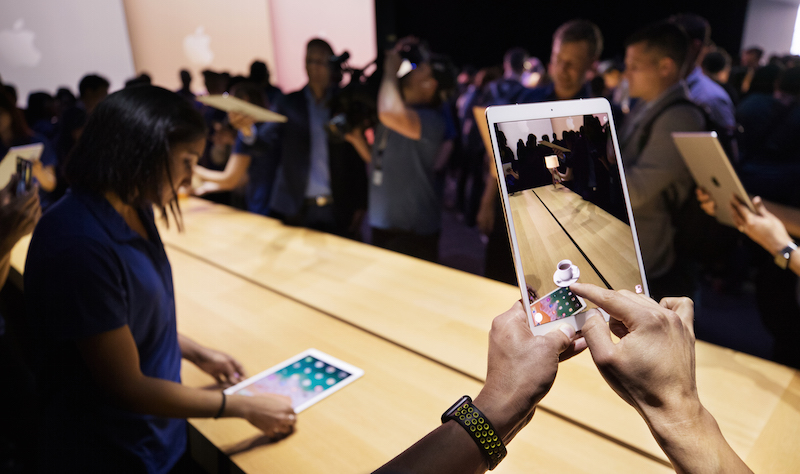Recapping WWDC 2017
At last year’s WWDC, Apple provided four consistent monikers for its ecosystem of products and services. The original Macintosh operating system would now be known as macOS. The iPhone and iPad world run on iOS while Apple Watch uses watchOS and Apple TV uses tvOS. Each of these tech pillars received attention at this year’s event. Let’s take a look.
tvOS
The world of AppleTV received the shortest attention, with Apple teasing more news to come later this year. The one item discussed: Amazon Prime Video will be coming to Apple TV. Amazon currently competes against Apple with their own Fire TV products, so this is a welcome feature for those Apple TV owners who use Prime.
watchOS
Apple Watch continues to gain momentum with a new version of the OS announced this year: watchOS 4. A host of new watch faces are coming in watchOS 4, including a series with characters from Pixar’s Toy Story. The most notable, though, is a Siri-powered watch face. This face uses Siri’s Proactive Intelligence to provide contextual information when used. Traffic reports will be shown when events with travel time are coming up. Integration with HomeKit, Apple’s home automation platform, will show as you arrive home.
Apple Watch has been a big hit as a fitness tracker. The combination of heart rate and motion tracking as well as integration with music from your iPhone has slimmed down the equipment used during workouts. A new workout tracker has been added to better monitor high intensity interval training—letting no burpee go unnoticed. Apple has also worked with major gym equipment manufacturers to sync data from their machines to the Apple Watch. Now all those metrics from your treadmill or stationary bike will match your Apple Watch reports.
macOS
The venerable desktop operating system established Apple as the premier software-hardware integrator. In the last several years, much criticism has been given to Apple for focusing on the mobile marketplace and taking the eye off macOS and the desktop. This year, Apple communicated that macOS wasn’t going to be left behind the advances seen in iOS and additionally will take the helm in high-end technologies like virtual reality.
Earlier this year, iOS saw the introduction of a new file system. While not the user facing feature that is going to sell devices, the Apple File System (aka APFS) is a critical system that sits between your operating system and your storage system. As hardware changes—larger and larger drives and a transition from spinning disks to solid state—it’s important that the software and algorithms in a file system stay optimized to that hardware. This file system is coming to macOS in 10.13 (aka High Sierra) to bring parity with iOS.
Many enhancements in macOS center around graphics. Metal version 2 is an update to an API layer that is optimized for Apple technologies, allowing 3D performance greater than industry standard APIs. A new developer kit is available, allowing desktop Macs to use external graphics cards (your computer is connected to a device housing an upgradable graphics card which connects to a monitor) and will allow Macs to use graphics cards released on faster pace than their desktop computer. Apple has been known for computer-based video since QuickTime premiered in 1991. This year, they introduced a new codec (aka video coder-decoder) called H.265 which features hardware accelerated compression, meaning richer video in smaller file sizes. Lastly in the graphics space, Apple announced support for Virtual Reality development including support for SteamVR, Unity VR, and Unreal VR engines.
While usually a software affair, Apple surprised WWDC attendees with several Mac hardware announcements. The iMac line received a major refresh: faster CPU, more drive space, and brighter screens with faster graphics. The MacBook line (with the consumer MacBook, travel-conscious MacBook Air and professional MacBook Pro) all received modest bumps as well.
Earlier this year, Apple revealed that their professional desktop line of computers was going to receive an overhaul. The current design of the Mac Pro isn’t able to keep up on the pace of graphics-heavy processing due to limitation of the physical and internal structure. While no further information came about the Mac Pro, Apple did announce an iMac Pro. This “all-in-one” monitor and computer takes the form and design of the popular iMac and maxes out processing and graphics to create a professional workstation for heavy tasks like 4K video editing or virtual reality authoring.
iOS
We’ve become accustomed to a yearly iOS release, and this year was no different. Apple officially announced iOS 11, which will be released this fall.
iMessage remains an important part of the iOS strategy as it differentiates iOS from other messaging platforms that run on both iOS and Android. The biggest messaging announcement this year is Apple Pay person-to-person payments. Combining Apple Pay and iMessage puts Venmo, SnapCash, and other mobile payment systems in Apple’s crosshairs. It should also herald an era of not getting stiffed by friends who have no cash when the bill arrives.
Siri continues to be a major area of investment for Apple. iOS 11 will provide a beta release of language translations through Siri. A handful of languages will be available initially with more to follow. Siri continues to lead over other voice assistants in the number of languages supported so this is a natural way to take advantage of that lead. Additionally, Siri will start learning how you interact with it and tailor responses to you based on your personal data and past experiences.
Augmented Reality (AR) comes to the developer masses as Apple releases ARKit, an API for developers to translate properties about the camera feed into a spatial 3D environment. ARKit will analyze the camera feed and determine walls, floors, and other planes in order to provide bearings for a 3D environment to synchronously overlay. Expect an explosion of augmented apps to arrive when iOS 11 is released.
While no iPhone hardware was announced, an updated lineup of iPads was shown. A new version of the iPad Pro features a 10.5-inch screen in the same housing as the traditional 9.7-inch iPad. It and the larger 12.9-inch iPad Pro received performance updates that rival laptops. Both feature a maximum screen refresh rate of 120Hz (120 refreshes per second). This faster refresh rate greatly improves animation like scrolling and allows the Apple Pencil to provide even faster feedback when drawing on the screen.
During its initial premier, Apple asserted that the iPad is the future of computing. The nuance to this statement isn’t that all desktop and laptop users will be using iPads, but instead, that the majority of computing users doing typical tasks like consuming media, web browsing, and light content creation can be done on this platform that offers more security and less maintenance than traditional operating systems. While consuming media and web browsing have been excellent experiences on the iPad, content creation has always been more like the iPhone and less like the Mac. iOS 11 plans to change that.
iOS users know that a double tap on the home button allows you to switch apps. With iOS 11, iPad users will now have a Dock similar to macOS to move between apps. The iOS Dock allows customization of what apps it displays alongside recent apps as well as providing the ability to work with files in those apps. Speaking of files, a new Files app for iOS will bring uniform file access to all that iPad content creation by integrating local files with cloud services like iCloud, Dropbox, Google Drive, and others.
Working with two apps at the same time on the iPad was made possible with multitasking support in iOS 9. The Split View feature will now work with the Dock to easily bring another app into view of your current app. This pairing of apps can also be preserved so you can return to it if it’s a combination you often use. And working with those apps is now more exciting with Drag and Drop support. Text, images, and files can now be easily copied between apps with a touch and drag.
Introducing HomePod
After news on their four main platforms, Apple introduced something brand new: HomePod. Aiming at both connected speakers from companies like Sonos as well as stand-alone smart assistants like the Amazon Echo, HomePod blends a high-end speaker with Siri. Inside, the HomePod features some impressive audio technology—an array of seven tweeters, a woofer, and 6 microphones—all controlled by the same type of CPU used in iPhones and iPads.
The HomePod’s processor elevates it from a connected speaker to a stand-alone audio device. In just audio capabilities, the array of microphones are used to determine the acoustic qualities of the room and adjust so that, for example, distortion is avoided when the device is placed on a shelf. The HomePod can also directly connect to your Apple Music account, meaning all 40 million+ songs are available directly without needing to control playing with your phone. And in case one isn’t enough, two HomePods in the same room can talk to each other and find the optimal sound, or place in different rooms and they can play in sync as you move around your house.
Siri literally takes center stage with HomePod by illustrating itself on the top display while listening to commands. Voice commands can take care of all music control—just call out an artist, album, or genre to start playing. Siri can also take care of the same news, weather, and sports questions you give it with your phone. Additionally, HomePod works with Apple’s HomeKit home automation platform to control lights, door security, and other appliances.
Never one to challenge the industry with budget devices, Apple is targeting HomePod at medium to high-end audio customers looking for home audio integrated with their current Apple devices and services. The HomePod will begin shipping in December for $349 and is available in two different colors.
To Recap
Apple has built a large portfolio of products and services over time, and previous years at WWDC have made it easy to pick on them for not continually investing in all of those technologies. This year saw attention given to all of those major platforms, and the developer community in attendance responded positively. Each of their platforms received updates and the themes across those platforms shows Apple’s key focuses: messaging, advanced graphics including Augmented Reality, and leveraging Siri’s intelligence.





